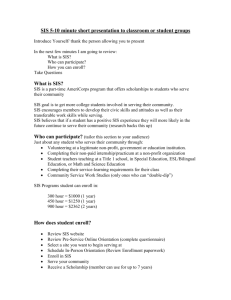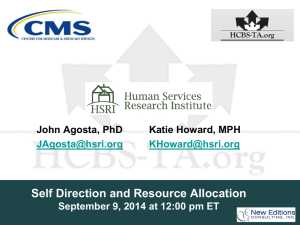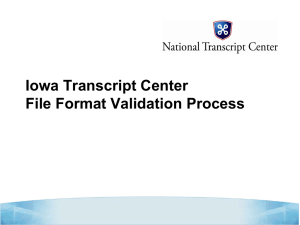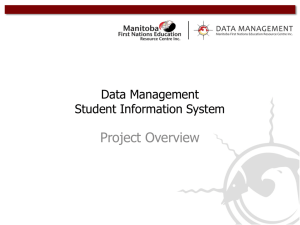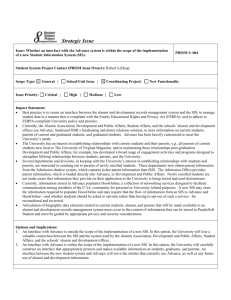SIS Baseline Research Plan
advertisement
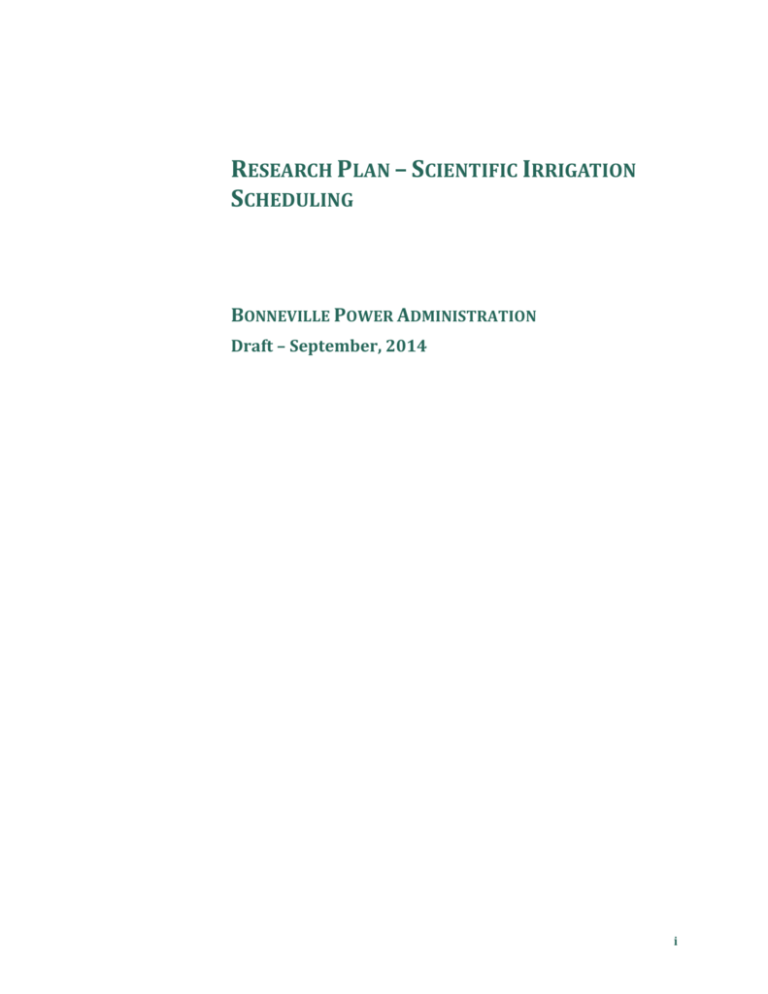
RESEARCH PLAN – SCIENTIFIC IRRIGATION SCHEDULING BONNEVILLE POWER ADMINISTRATION Draft – September, 2014 i Provisional Research Plan Template TABLE OF CONTENTS 1. INTRODUCTION ................................................................................................................1 1.1. Measure Specification .......................................................................................................................... 1 1.2. Research Objectives .............................................................................................................................. 2 1.3. Limitations of Proposed Research .................................................................................................. 3 2. SAMPLE DESIGN AND DATA COLLECTION PLAN .............................................................4 2.1. Sample Design ......................................................................................................................................... 4 2.2. Data Collection ........................................................................................................................................ 5 3. ANALYSIS PLAN ...............................................................................................................5 4. RECOMMENDATIONS FOR COLLABORATION ...................................................................6 5. BUDGET ...........................................................................................................................6 ii Bonneville Power Administration Provisional Research Plan Template 1. INTRODUCTION The research objective is to inform and validate a simple and reliable approach to estimating energy savings due to scientific irrigation scheduling (SIS). Historically, the RTF has estimated SIS savings as 10% of efficient-case energy consumption, but the empirical basis for this approach is not sufficient to meet the reliability standard for a proven standard protocol. Generally, this research is focused on developing an estimate of the “Average Percent Deviation from Water Requirement” (1reference Quantec study for definition). This will be used to estimate savings in the following way: Savings = (Baseline Water Application - Actual water applied)* Water to Energy conversion Where: Water to energy conversion = Conversion from water use to energy use using the regional calculator, including factors for lift, discharge pressure, pumping plant efficiency, etc. Actual water applied = water applied by crop, as measured by SIS water consultants Baseline water application = Water Requirement * Average percent increase over Water Requirement, where: o Water requirement = specific water requirement for the crop, as determined by the SIS consultant o Average percent deviation from Water Requirement = Amount of water above water requirement for average of all farms. 1.1. Measure Specification Scientific irrigation scheduling uses a combination of soil moisture monitoring, climatic data, field specific data, and water measurements to optimize the timing and volume of irrigation. Relative to current irrigation practices, SIS reduces electric use by reducing the amount of water used for irrigation, which in turn reduces the work required to pump this water. Market Sector Agriculture Measure Specifications None specified. 1 http://www.bpa.gov/EE/Utility/research-archive/Documents/200354_Phase_II_25JUL05_final.pdf Bonneville Power Administration 1 Research Plan Template (Utility program managers assess SIS provider qualifications) Baseline Current Practice Estimation Method Standard Protocol Category Provisional Estimation Procedure Statistical Sunset Date 12/30/2019 Sunset Factors Completion schedule for research plan. Number of Measure Applications One (The RTF does not define multiple types of SIS participation) The simplest reliable method is described in detail in the provisional standard protocol. The method seeks to estimate an SIS application’s energy savings in two steps: 1. Estimate water savings as a fixed percentage of the actual water requirement2 for the acreage served by the affected pump station, then 2. Convert water savings to energy savings based on the pump station’s efficiency and total dynamic head (TDH). The main research objective is to inform Step 1 above by estimating the average percent deviation from the water requirement. Step 2 is conducted in the current calculator and outlined in the standard protocol. 1.2. Research Objectives The main research objective is to estimate the baseline for SIS. This baseline is the average percent deviation from water requirement. Using a percent deviation simplifies the baseline calculation and accurately reflects the measure’s objectives. The measure aims to help growers irrigate the appropriate amount for that field based on multiple variables, including evapotranspiration, length of growing season, crop type, precipitation, irrigation sprinkler system efficacy and antecedent soil moisture. These varying field-specific conditions could mean that a field treated by SIS is appropriately irrigated but uses more absolute water than another field which is not treated by SIS and is overirrigated yet uses less absolute water. In other words, the absolute water applied is not reflective of the appropriate amount of water that should be applied, which is determined by many factors. 2 The water requirement is the annual gross water requirement for the crop over the season accounting for evapotranspiration, length of growing season, crop type, precipitation, and antecedent soil moisture. This is the calculated amount of water that would be pumped. The water requirement is the “ideal” water amount applied to the crop. 2 Bonneville Power Administration Provisional Research Plan Template This focus on the percent deviation from water requirement simplifies the sampling strategy and provides a basis to allow comparison across the region’s irrigated acreage. The water requirement will be measured by water consultants using the same methods used when developing the recommendations on SIS treated fields. This requires using soil moisture measurement devices (like the Neutron probe), actual water applied (like a rain gauge) and crop specific ET data from the appropriate weather station (like AgriMet or others) Actual consumption will be based on measured water application. The research will use multiple methods to estimate the actual water flow. These can include a water-applied method (center pivot sprinkler package flow rating) and measured pivot irrigation run-time. One complicating factor in the research is the weather and seasonal water restrictions. An unusually dry or wet growing season will impact the final results in unknown ways. As the research is implemented, the consideration of drought conditions and water restrictions will be reviewed and the research may adapt to these changing conditions. Drought conditions could affect what fields are included in the analysis and the timeline of the research. For instance, if summer of 2015 is a drought year, then the study might continue for an additional growing season of summer of 2016 or fields might be excluded from the final analysis. 1.3. Limitations of Proposed Research Methodological issues will be determined throughout the research implementation. These include: Defining the SIS-eligible population. There are around six million acres of pressureirrigated acreage in the Pacific Northwest. However, not all of these acres are a prime candidate for SIS because of the water source, water availability, crop type, growing season, and the pumping energy required. See section 2.1 for detail. Segmentation Plan. Prior to implementing this research, a segmentation plan will be developed to provide a balance between number of fields that will need to be included in the sample and granularity to account for meaningful market segments. See section 2.2 for detail. Measurement plan. Refinement of the methods to determine actual water applied and the water requirement will be developed and methods to account for any bias developed. See section 2.4 for detail. Field recruitment. Incentives or a value proposition for fields that are outside of the SIS treated fields will need to be developed as well as protocol for research on-site to minimize end-user disruption. See section 2.3 for detail. Bonneville Power Administration 3 Research Plan Template 2. SAMPLE DESIGN AND DATA COLLECTION PLAN The following describes the research plan steps. Section 2.1 describes defining the population; Section 2.2 the segmentation design; Section 2.3 the data collection and Section 2.4 the analysis. 2.1. Defining the Population There are approximately six million acres of pressure-irrigated acreage in the Pacific Northwest. However, not all of these acres are a prime candidate for SIS because of the water source , water availability, crop type, growing season, and the pumping energy required to get the water to the field. The research will use USDA data to develop population estimates and then present these population estimates to stakeholders. Agricultural and energy efficiency experts in the region will help refine and improve these definitions such that the final population definition reflects an accurate baseline. The following will be considered at a minimum: (1) whether an irrigated field is a likely SIS candidate based on crop type and irrigation type; (2) crop type and (3) regional variations. BPA envisions a working meeting in December 2014 to review BPA’s initial analysis. 2.2. Sample Design At a minimum, we seek to estimate a single percentage deviation from the water requirement for all crops and sites. However, due to variations in irrigation practices, segmenting the sample will likely provide more accuracy. That said, each sample cell will require an increased number of sites, so balancing the desire for segmentation with the cost of increased sites will be important for the feasibility of the field work. It is likely that the segmentation will consider: Crop type, region, and system type. Additional considerations include: Soil type, Cutting, Climate zone, Grower size, Farm size, Sophistication, Water constraints. The segmentation plan will determine which of these factors are accounted for in the water requirements calculation and which are needed for segmentation for the program’s implementation. Within the sample design, a sample frame will be determined. It is important that the research is based on an unbiased, random sample of farms. The most feasible method will be determined to develop a sample list or choose farms. 4 Bonneville Power Administration Provisional Research Plan Template 2.3. Data Collection The data will be collected on fields using experienced water consultants. The data collection will have to begin in order to be in the field for the growing season in March. Critical components that could affect data collection in the field include recruiting nonparticipating fields, drought conditions and continuous QC of data throughout the data collection period. The plan to recruit non-participating fields will be developed in coordination with utility stakeholders. Possible methods to help recruit fields could include participation of utility staff, paying for the SIS information and providing it at the end of the growing season, or the use of financial incentives for growers. In the event of an unusual water year, the research team will meet with the SIS subcommittee, engaged experts and RTF/Council staff to develop a contingency plan. The research team will monitor climate forecasts regularly. Once in the field, monthly QC checks by the analysts will be performed to address any problems with data quality or equipment. A QC checklist will be developed early within the project so that data problems can be identified quickly and resolved. Once the fields are identified, we will use one or both of the following estimates to calculate water applied by field: Measurement of water applied. This is conducted by a consultant on a field using a catch can/rain gauge and soil moisture probes. This can be used for pivots and hand/wheel lines, but not for orchards and vineyards. Measurement will adjust for water balance (soil moisture before and after season) and adjusted for rainfall. Irrigation run-time. This method can be used on pivots and on orchards/vineyards, by zone. It will use a data logger and a pressure sensor on the pressure gauge. Measurement will adjust for water balance (soil moisture before and after season). Prior to implementation, BPA will refine which applications will be appropriate for one or both to measure water applied. The water consultants will use the methods used via SIS ( weekly reports of moisture measurements and weather information and irrigation recommendations) to help determine the appropriate level of irrigatation for that particular field. The details of this approach and how data will be provided for analysis will be further refined before the fieldwork commences. 3. ANALYSIS PLAN The analysis will be ongoing, as QC of field data and weather monitoring will occur throughout the field data collection. Once the field data are completely collected, each site will have an Bonneville Power Administration 5 Research Plan Template water requirement and an amount irrigated. The two combined will develop a percent deviation from the water requirement. One analytical decision that will need to be determined is the treatment of outliers. The 2005 BPA study found that the savings were inconsistent, with a few farms accounting for most of the deviation above the water requirement. Sites may need to be weighted to the population depending upon the sample segmentation. 4. RECOMMENDATIONS FOR COLLABORATION This research would require support and collaboration between multiple entities. BPA will be the project manager of this project, including coordination, analysis and funding. This project will require support by public and investor owned utilities to working with growers in the sample. Sites in IOU territories will need to funded by those utilities. Additionally, coordination with SIS consultants will be required, as this is the method to gather most of the data. 5. BUDGET The government estimate of cost cannot be shared publicly due to BPA federal contracting guidelines. 6 Bonneville Power Administration
